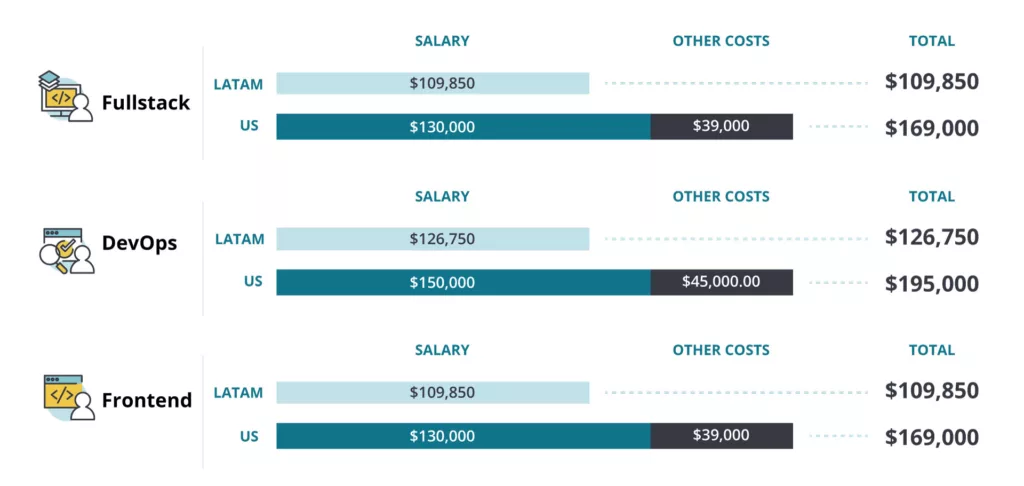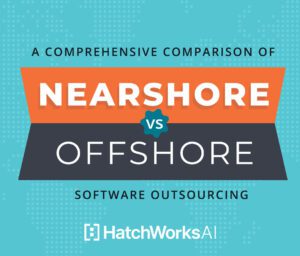Your business has software needs. The question is…do you take the time to hire an in-house development team or outsource the work to an already assembled team of experts?
This 2025 Essential Guide gets you to your answer. In it, we compare these two models side by side looking at their cost, quality, speed and more. Plus, there are four simple steps at the end to help you make your choice.

Read on to find out if an outsourced software development model suits your business needs or if you’re better off building a team in-house.
Or maybe your answer lies somewhere in the middle? There’s only one way to find out…
What is In-House Software Development?
Simply put, in-house software development is when you have an internal team managing and building software for your business.
It can be any size team, from a one-person band to a 20-piece orchestra of talented developers.
Who chooses in-house software development?
Usually, it’s:
- Large corporations with specific needs
- Tech companies with ongoing development projects
- Businesses prioritizing tight control over their tech
For example a SaaS business is likely to employ developers because the software is the heart of the product and will need constant tuning and adapting as users provide feedback and bugs pop up over its lifetime.
Benefits of In-House Software Development
One of the key benefits of in-house development is control.
You’re the boss of the software project from start to finish. Your software development team is right there with you, fully integrated into your company’s culture and goals.
This close-knit environment fosters a deep understanding of your project’s unique needs in a way the average software development company can’t.
And ultimately, investing in an in-house team is a long-term play.
You’re intentionally collecting and fostering talent that knows your business inside out. Over time, this can lead to more efficient, tailored software solutions that really hit the mark.
💡Helpful hint: Having an in-house team doesn’t automatically rule out an outsourcing model. You can use an outsourced team and an internal software development team for different projects or integrate outsourced developers into your internal team to enhance capabilities.
And What Does Outsourcing Look Like in Software Development?
As opposed to in-house, outsourcing software development is when you hire an external company, team, or individual to develop software for your business.
There are three main models of outsourcing for software development:
- Onshore software development (hiring a local company, usually a boutique agency)
- Offshore software development (hiring cheap labor from far off lands such as Asia)
- Nearshore software development (hiring teams from neighboring countries such as those in Latin America)
And within those models are types of outsourcing.
These include:
- Staff augmentation
- Dedicated teams
- Outcome based projects (a rare offering from custom software development companies)
At HatchWorks, we offer all three of the above types of outsourcing through our Nearshore model.
| Nearshore | Offshore | Onshore |
|---|---|---|
|
Outsourcing to neighboring countries with similar time zones.
|
Outsourcing to distant countries with significant time zone differences.
|
Outsourcing within the same country.
|
|
Often cost-effective and allows for easy collaboration.
|
Often cost-effective but can present difficulties in communication.
|
Often costly but avoids cultural differences and language barriers.
|
|
Central and South America
|
Africa, Europe, and Asia
|
United States and Canada
|

Even companies with in-house development teams may still outsource development for certain projects.
Here are some examples of businesses that would outsource software development:
- Startups needing to ramp up quickly without the overhead of a full team
- Small to medium-sized businesses looking for specialized skills not available in-house
- Large corporations handling overflow work or specific projects outside their core expertise
Benefits of Outsourcing Software Development
Outsourcing, when done with a reliable software development provider, gives you fast access to top talent.
And some outsourcing development models, like Nearshore Development, are cost-effective. They offer the benefits of outsourcing, like reduced labor costs, while minimizing issues like time zone differences.
It’s a smart way to get quality work done within a reasonable budget.
💡Helpful hint: Outsource the software development work your in-house team doesn’t have the time or skills to complete. This can be all of a software development project or a portion of it.
Comparing the Two Side by Side
Let’s look at these two approaches to software development to see the strengths and weaknesses of each when it comes to:
- Cost
- Quality & control
- Speed & efficiency
- Scalability & flexibility
- Access to talent & expertise
Each category starts with our winner (marked with a 🥇gold medal). Then you can read into each one to understand why and come to your own conclusions.
Cost Differences

🥇 We give first place to outsourcing, and Nearshore outsourcing specifically. It gives you access to top talent without spending time and money recruiting and hiring developers.
In-House Software Development Costs:
You’re looking at salaries, benefits, workspace, and ongoing training for your team.
According to Indeed, the average salary of an in-house developer in the US is $117,845.
Multiply that by the number of developers you need and be sure to add the costs associated with hiring, and the costs of learning and development.
It’s a significant upfront and ongoing investment, but it can pay off in the long term because you build a team that deeply understands your business and where expenses stay the same regardless of the project they’re working on.
Outsourcing Costs:
Outsourcing is more cost-effective in the short term. You pay for the service without the overheads of full-time employees.
Costs vary widely depending on the location and expertise of the outsourced development team. That means you can find something almost no matter what your budget is.
Nearshore outsourcing offers cost savings without significant time zone challenges and has talented developers at the ready.
At HatchWorks, we take a consultative approach, really getting to know your business so that we can operate with the same care, knowledge, and diligence as an in-house team while saving you the hassle of hiring one.
Quality and Control Differences
🥇Coming out on top of quality and control is in-house development teams. Why? Because not only do you have more control over what work is done and when, you also have more complete control over the quality itself.
In-House Software Development Quality and Control:
With an in-house team, you have direct oversight of the entire development process.
This close proximity allows for a hands-on approach to quality control. You can quickly address issues, make adjustments, and ensure that the final product aligns closely with your vision and standards.
The result is often a high-quality product that seamlessly integrates with your existing systems and business processes.
Outsourcing Quality and Control:
Outsourcing, while offering access to a wide range of expertise, can present challenges in maintaining the same level of quality control.
Communication barriers, cultural differences, and time zone mismatches can complicate project management.
However, with a reliable outsourcing partner and effective communication tools, these challenges can be mitigated.
The key is to establish clear expectations, maintain regular communication, and choose a partner with a proven track record of delivering quality work. This is made easier with software development companies who use a Nearshore outsourcing model because they’ll work in the same timezone as you and can have instant communication.
Speed and Efficiency Differences
🥇This category goes to outsourcing. Having a team of specialists focused on one thing and one thing only keeps things moving quickly.
In-House Software Development Speed and Efficiency:
Having your team on-site means communication is quick.
Decisions and changes can happen fast. This can lead to a shorter time-to-market, especially for projects that need close collaboration or have many moving parts.
However, if your in-house team is juggling multiple projects or lacks certain expertise, this could slow things down.
Outsourcing Speed and Efficiency:
Outsourcing can be a game-changer for speed, especially if you partner with a team that’s ready to hit the ground running.
They bring specialized skills and can focus solely on your project, potentially speeding up development.
But, remember, if you’re dealing with time zone differences or communication gaps, this can impact the pace.
Scalability and Flexibility Differences
🥇Outsourcing wins here too. It’s always flexible and scalable (with the right partner). And it does both with relative ease.
In-House Software Development Scalability and Flexibility:
Scaling an in-house team can be a slow process. It involves hiring and training new staff, which takes time and resources.
However, once scaled, an in-house team offers great flexibility.
They can quickly adapt to new technologies or changes in project scope, as they are fully integrated into your company’s ecosystem and understand its evolving needs.
Outsourcing Scalability and Flexibility:
Outsourcing shines in scalability.
You can quickly add more resources or cut back as needed without the complexities of hiring or layoffs. This makes it easier to manage workloads and adapt to changing project sizes.
However, while outsourced teams can bring in new technologies and skills swiftly, aligning them with your software development project’s specific needs and making changes in direction might require more coordination and time, especially if dealing with external teams in different time zones.
Access to Talent and Expertise Differences
🥇We have to give this one to outsourcing. Companies are struggling to hire tech talent. With an outsourcing provider you can get access to proven talent a lot sooner than the months it takes to find and hire.
In-House Software Development Access to Talent and Expertise:
Building an in-house team means you’re limited to the current talent pool.
This can be a challenge, especially in competitive industries (and aren’t they all?).
Especially when you consider 53% of companies struggle to recruit in-house developers because they lack the skills desired. That can lead to months wasted looking for talent that never comes.
While you can cultivate a team with a deep understanding of your business, finding and retaining top talent with specialized skills can be difficult and costly.
Outsourcing Access to Talent and Expertise:
Outsourcing on the other hand opens up a world of global talent. You’re not restricted by geography; you can find the best fit for your project, whether they’re across the country or on a different continent.
This access to a diverse pool of skilled professionals means you can easily find experts for niche or specialized areas of your project. And if needed you can find software development providers who are harnessing generative AI tools to enhance their software development processes.
The challenge is in making sure these external experts align with your project goals and company culture, but the breadth of talent available often outweighs this hurdle.
How to Choose the Software Development Model That’s Right for Your Business
So do you build an in-house team, hire software developers, look for external help, or look to do both for different projects?
Your choice largely depends on the:
- needs of your business right now and in the future
- the goals you want to achieve and what you need to achieve them
- and if you think you can replicate these models successfully as others have.
1. Assess Your Business Needs
Start by evaluating your business needs and project requirements.
Consider the scope of your project, the skills required, and the timeline. Does your project require specific expertise that your current team lacks? How quickly do you need to move from concept to launch?
Aligning your business strategy with your development approach is essential.
If your business values tight control over projects and has the resources to invest in a long-term team, in-house development might be the way to go.
On the other hand, if you need to scale quickly or require specialized skills for a short-term project, outsourcing could be more effective.
2. Consider Long-Term Goals and Objectives
Think about where you see your business in the next five to ten years.
Are you planning to expand into new markets? Will you need to innovate rapidly to stay ahead of the competition?
In-house teams can evolve with your business, offering stability and consistent alignment with your long-term vision.
However, outsourcing offers the agility to adapt to changing market demands and can be a powerful tool for businesses looking to scale or innovate quickly.
3. Take Inspiration from Real-World In-House Development and Outsourcing Examples
Real-world examples can offer valuable insights.
A tech startup you know might begin with outsourced development to quickly launch their product, then transition to an in-house team as they grow.
Another business might use nearshore software development for a specific project to benefit from cost savings and time zone alignment, while maintaining a high level of quality and control.
Each approach has its own set of challenges and lessons learned.
For example, a business that outsourced might have faced communication hurdles but benefited from accessing a wide range of skills.
On the other hand, a company with in-house development might have struggled with the initial setup but gained from having a dedicated team aligned with their core business and culture.
Take stock of these examples whether you know the company personally or read about them online and see if you see yourself in them.
Need inspiration? Check out our case studies to see examples of companies who flourished with Nearshore Software Development on side.
Finally, Make Your Decision
Now that you’ve taken stock of your business needs, know your goals, and have proven use cases of others in similar situations you can decide whether you’ll build an in-house development team or outsource all or some of the projects you have.
This involves weighing the pros and cons of each approach in the context of your business’s unique situation.
Here are some key factors to consider:
- Budget Constraints: Determine how much you’re willing to invest. Remember, in-house development often requires a higher upfront investment, while outsourcing can be more variable but potentially less costly in the short term.
- Project Complexity and Duration: For complex, long-term projects, an in-house team might offer better consistency and understanding. Short-term or highly specialized projects might benefit more from outsourcing.
- Control and Communication: If having direct control and immediate communication is vital for your project, in-house development might be preferable. If you’re comfortable managing remote teams and can handle potential communication challenges, outsourcing could work well.
- Talent Availability: Consider the availability of the required skills in your local market versus the global talent pool accessible through outsourcing.
- Risk Tolerance: Assess your tolerance for risks associated with each model, such as the potential for communication issues with outsourcing or the challenges of scaling an in-house team.
In the end, the decision should align with your business values, goals, and the specific needs of the project at hand.
It’s also important to remember this isn’t a one-size-fits-all choice; some businesses successfully use a hybrid model, leveraging the strengths of both in-house and outsourced development.
If you’re going the outsource route here are some resources to help you choose:
Outsourcing Reimagined: AI Nearshore Experts
Looking to outsource software development? HatchWorks makes it easy to scale with confidence.
We specialize in blending AI innovation with Nearshore Software Development, connecting you with top-tier talent across the Americas—all within your time zone.
Our Generative-Driven Development™ approach delivers faster, higher-quality software, turning your AI initiatives into measurable results. As a trusted partner, we operate as an extension of your team, fully aligned with your business goals.
Ready to take the next step?
We’re ready to support your project!
Instantly access the power of AI with our AI Engineering Teams.




